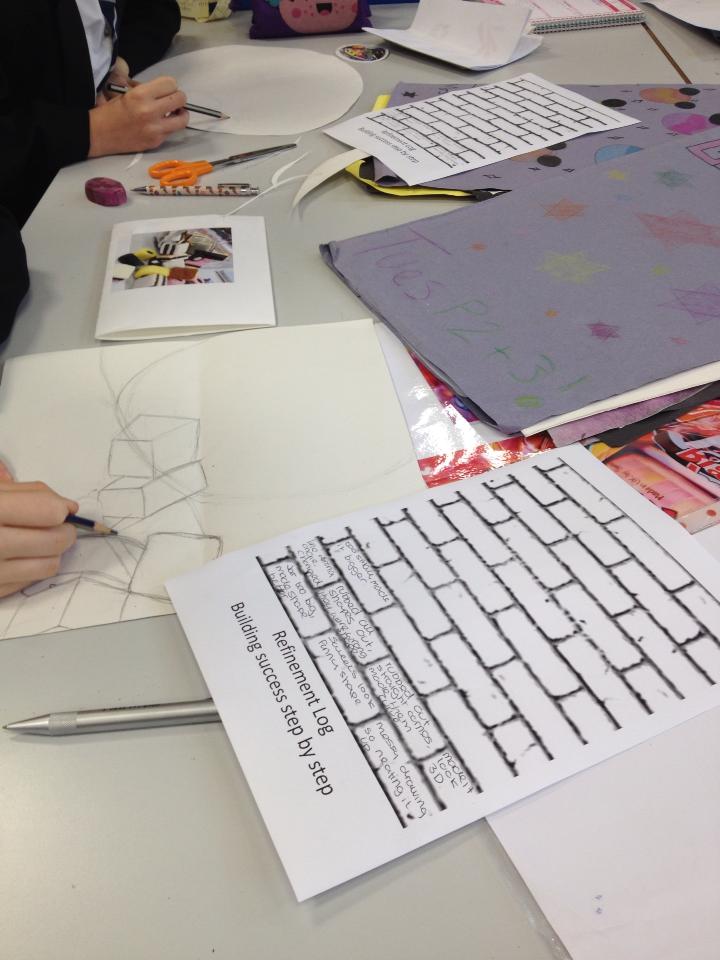Having two kids of my own and with a bit of useful research under my belt, I have looked at how kids make sense of drawing faces. Funnily enough, for most of us, after inane scribbles, come two distinctive dots. Eyes, like little raisins. Our way of making sense of the world- as eye contact is such an elemental piece of early life. Putting these two raisins down on a bit of paper is a real breakthrough for the early artist.
Next comes the head. Again, the eyes are often drawn first, with the head, often a huge ball with the eyes sitting somewhere near the top of the head. Again, as little people, we see these huge people (adults) and looking up we see their eyes at the top. Makes sense eh?
Anyway. Eventually, we all start adding detail. But all of this comes from our memories, not from first hand discrimination. This continues until we are suddenly taught the power of noticing. For most, this is an incredibly difficult habit to break.
Last week, I introduced my students to the incredible work of Kelvin Okafor. He works with pencil, graphite and charcoal and has been stunning the art world with his hyperrealist drawings.
Starting the lesson with an introduction to how we all draw as kids, from 2 to 12, looking at all the habits we develop as we grow as artists. Pointing out these habits really helps students address their current practice. I speak about the fact that these habits will not be broken without deliberate practice, a belief that they can improve and that without significant effort, mastery of drawing cannot happen. Students see that I can draw with relative ease. If their own drawings went wrong in the past, I would be the first port of call. ‘Sir I cant do it’, ‘it’s too difficult’. I would always look at their work and explain what was wrong, often showing them how to correct it, and so prolonging their learned helplessness. Then I read this post from the Learning Spy himself, David Didau, where he states; “ If we insist that pupils annotate every piece of work with the mistake they are able to spot, our clarification can then be applied with pin-point accuracy at the exact they have identified as where they are ready to learn. They will receive feedback only on those areas they’ve identified as containing errors or misunderstandings.”
Get in! I decided to give students about 30 pieces of orange paper I’d cut up. Each time they noticed a mistake, they would write it down, take a photo and correct what they’d done. Within twenty minutes, several students had used all these bits of paper.
In the past, often students would have carried on regardless and ended up with a seriously dysfunctional drawing that would scare the majority of Year 7s. But now, due to their own diligence and critique they were now constantly and consistently addressing the flaws in their work AND doing something about it.
 Having the photographic commentary of their mistakes has been really useful in analysing common mistakes and provides great visual journey of their progress to mastery.
Having the photographic commentary of their mistakes has been really useful in analysing common mistakes and provides great visual journey of their progress to mastery.
It allowed me to be far more nuanced in my own feedback, commenting on more delicate errors. The path to mastery has just gotten that bit more student driven.
As Paul Klee once said, ‘A line is just a dot going for a walk’, and as Mr Jones said ‘So jog on then kids!’
UPDATE:
Since writing this post, I know a few wonderful teachers have developed this idea and made it their own. I thought I’d share a couple.
The unbelievably brilliant @Jobaker9, developed the idea of using an A3 print out of a brick wall, where students commented on each brick about the mistakes made and developed understanding. She wrote;
The kids (the group I dread the most) were really keen to fill in the boxes, it too no time to explain what I wanted them to do, so they just got on with it – we were drawing out their large composition, ready to start painting next week. The work is based on Sarah Graham’s sweets.
Tyler said ‘I wanted to alter the little errors, you know, the ones you’d normally just ignore, well, I I wanted to change them’.
Georgia said she felt more confident, like she wasn’t worried about how many times she had ‘gone wrong’, she didn’t feel frustrated, and each time she wrote something down, it was like a worry had gone from her head, rather than bottling them all up, and then saying ‘I can’t do it’.
Others said they liked it as they could see others were refining too – they felt like everyone around them just effortlessly does good work, and it made them feel more comfortable knowing they also have to work at it.

 They said it was nice to SEE others refining their work, as they just assume they do it perfectly first time etc. Fabulous eh?
They said it was nice to SEE others refining their work, as they just assume they do it perfectly first time etc. Fabulous eh?
And @ewenfields, remarked on a lesson study observation where @rachel_young84 adapted the ideas and made this excellent PPT to develop the thinking of her students.





